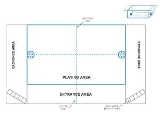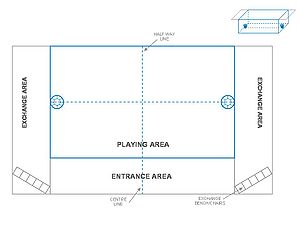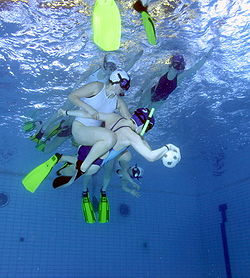
Underwater rugby
Encyclopedia

Rugby football
Rugby football is a style of football named after Rugby School in the United Kingdom. It is seen most prominently in two current sports, rugby league and rugby union.-History:...
except for the name.
It is played underwater in a pool with a depth of 3.5m to 5m and goals (heavy metal buckets with a diameter of about 40 cm) at the bottom of the pool. Two teams (blue and white), each with six players (plus six substitutes), try to score a goal by sending the slightly negatively buoyant ball (filled with saltwater) into the opponents’ goal. It is a fast and exhausting game; therefore, the subs replace their players on the fly.
The ball may be passed in any direction but must not leave the water. It "flies" about 2m or 3m before water resistance stops it. This makes good tactics and good (three-dimensional) positioning essential. The players can use different abilities: Strength
Physical strength
Physical strength is the ability of a person or animal to exert force on physical objects using muscles. Increasing physical strength is the goal of strength training.-Overview:...
, speed, mobility or simply low consumption of oxygen are all similarly important.
Not many people play underwater rugby, so it is often played in mixed male-female teams.

History
In 1961 a member of the German Underwater Club (DUC) in CologneCologne
Cologne is Germany's fourth-largest city , and is the largest city both in the Germany Federal State of North Rhine-Westphalia and within the Rhine-Ruhr Metropolitan Area, one of the major European metropolitan areas with more than ten million inhabitants.Cologne is located on both sides of the...
, Ludwig von Bersuda, came up with the idea of an underwater ball game. Air-filled balls are not suitable for underwater games, as they are buoyant and always return to the surface. The first underwater ball was invented when Bersuda filled the ball with saltwater. Since the density of the ball was now greater than that of normal water, it no longer floated to the surface, but slowly sank to the bottom. The sink rate could, within certain limits, be controlled by the concentration of the salt solution. As soccer balls are too large to be practical, waterpolo balls are used.
Ludwig von Bersuda spanned the middle of the pool with a net, as in volleyball
Volleyball
Volleyball is a team sport in which two teams of six players are separated by a net. Each team tries to score points by grounding a ball on the other team's court under organized rules.The complete rules are extensive...
, that stopped 1 m above the pool bottom. Two teams played against each other: the offensive team had to carry the ball to the opposing field and put it into a bucket. The idea for the game was ready, and the DUC Cologne used it to warm up before normal training. Other teams saw this and started to use saltwater-filled balls themselves.
The "Cologne Discipline" was demonstrated as a competition sport at the national games in 1963, probably the first official game with an underwater ball. At the time, though, there was not much interest shown.
Dr. Franz Josef Grimmeisen, a member of the German Underwater Club in Duisburg
Duisburg
- History :A legend recorded by Johannes Aventinus holds that Duisburg, was built by the eponymous Tuisto, mythical progenitor of Germans, ca. 2395 BC...
, a city near Cologne, decided to make a competitive sport from this ball game. The German Lifeguard Association (DLRG
DLRG
The Deutsche Lebens-Rettungs-Gesellschaft e.V. is a relief organization for life saving in Germany. The DLRG is a non-profit, independent organization based on volunteers.-Tasks:...
) of Mülheim
Mülheim
Mülheim an der Ruhr, also called "City on the River", is a city in North Rhine-Westphalia in Germany. It is located in the Ruhr Area between Duisburg, Essen, Oberhausen and Ratingen...
(since 1967 TSC Mülheim/Ruhr) had founded a divers' club, and through contact with members of DUC Duisburg learned of the game. With their help, Grimmeisen arranged the first underwater rugby game on Sunday October 4, 1964. It took place between DLRG Mülheim and DUC Duisburg. DUC Duisburg won the game 5-2. The next edition of the Essener Tageblatt carried the story.
Grimmeisen kept promoting the ideas of an underwater rugby tournament to give the sport a character of serious competition. Together with the scuba-diving section of the DUC Mülheim/Ruhr, to which six players of DUC Duisburg came, he organized the first underwater rugby tournament rules, and the "Battle for the Golden Ball" in Hallenbad Sued, in Mülheim/Ruhr. The premiere was on November 5, 1965. Six clubs sent teams to Mülheim: DUC Bochum
Bochum
Bochum is a city in North Rhine-Westphalia, western Germany. It is located in the Ruhr area and is surrounded by the cities of Essen, Gelsenkirchen, Herne, Castrop-Rauxel, Dortmund, Witten and Hattingen.-History:...
; DUC Düsseldorf
Düsseldorf
Düsseldorf is the capital city of the German state of North Rhine-Westphalia and centre of the Rhine-Ruhr metropolitan region.Düsseldorf is an important international business and financial centre and renowned for its fashion and trade fairs. Located centrally within the European Megalopolis, the...
, DUC Duisburg, DUC Essen
Essen
- Origin of the name :In German-speaking countries, the name of the city Essen often causes confusion as to its origins, because it is commonly known as the German infinitive of the verb for the act of eating, and/or the German noun for food. Although scholars still dispute the interpretation of...
and TSC Delphin Lüdenscheid
Lüdenscheid
Lüdenscheid is a town in the Märkischer Kreis district, in North Rhine-Westphalia, Germany. It is located in the Sauerland region. Lüdenscheid is seat of the administration of the Märkischer Kreis district...
. The rules of those days allowed 8-player teams, and DLRG Mülheim, the home team, came away winners, against DUC Duisburg (for whom Dr. Grimmeisen played).
The tournament has been held every year since then, which makes it the oldest tournament in the history of the sport. The Cologne version of the game was only played for a short time thereafter in Cologne, and has been long since forgotten. The Cologne team itself also turned to underwater rugby. To bring this game to the international arena, Grimmeisen turned to the two then most important members of the World Underwater Federation (CMAS
Confédération Mondiale des Activités Subaquatiques
The Confédération Mondiale des Activités Subaquatiques is the World Underwater Federation. CMAS is the international umbrella organisation for recreational diver training organisations represented in the CMAS Technical Committee and underwater sports governed by the CMAS Sport Committee...
), France
France
The French Republic , The French Republic , The French Republic , (commonly known as France , is a unitary semi-presidential republic in Western Europe with several overseas territories and islands located on other continents and in the Indian, Pacific, and Atlantic oceans. Metropolitan France...
and the USSR. He offered demonstration games and press coverage. Sadly, interest was not forthcoming. Just one French sport magazine, L'Equipe
L'Équipe
L'Équipe is a French nationwide daily newspaper devoted to sports, owned by Éditions Philippe Amaury. The paper is noted for coverage of football , rugby, motorsports and cycling...
, printed a short article in its April 9, 1965 edition.
The Scandinavian countries showed more interest, and adopted the ideas in relatively short time. A demonstration in Denmark
Denmark
Denmark is a Scandinavian country in Northern Europe. The countries of Denmark and Greenland, as well as the Faroe Islands, constitute the Kingdom of Denmark . It is the southernmost of the Nordic countries, southwest of Sweden and south of Norway, and bordered to the south by Germany. Denmark...
in 1973 and in Finland
Finland
Finland , officially the Republic of Finland, is a Nordic country situated in the Fennoscandian region of Northern Europe. It is bordered by Sweden in the west, Norway in the north and Russia in the east, while Estonia lies to its south across the Gulf of Finland.Around 5.4 million people reside...
in 1975 were effective. Games in Belgium
Belgium
Belgium , officially the Kingdom of Belgium, is a federal state in Western Europe. It is a founding member of the European Union and hosts the EU's headquarters, and those of several other major international organisations such as NATO.Belgium is also a member of, or affiliated to, many...
in September 1973 and Vienna
Vienna
Vienna is the capital and largest city of the Republic of Austria and one of the nine states of Austria. Vienna is Austria's primary city, with a population of about 1.723 million , and is by far the largest city in Austria, as well as its cultural, economic, and political centre...
in 1979 were ineffective in generating interest. In the Eastern Bloc
Eastern bloc
The term Eastern Bloc or Communist Bloc refers to the former communist states of Eastern and Central Europe, generally the Soviet Union and the countries of the Warsaw Pact...
, only Czech
Czechoslovakia
Czechoslovakia or Czecho-Slovakia was a sovereign state in Central Europe which existed from October 1918, when it declared its independence from the Austro-Hungarian Empire, until 1992...
teams were interested, and they, according to the politics of the time, played only against teams from other communist countries. The only tournament known to have taken place there is the Underwater Rugby Tournament in Prague, which has taken place every year since 1975 (with the exception of 1979). In later years, Polish
Poland
Poland , officially the Republic of Poland , is a country in Central Europe bordered by Germany to the west; the Czech Republic and Slovakia to the south; Ukraine, Belarus and Lithuania to the east; and the Baltic Sea and Kaliningrad Oblast, a Russian exclave, to the north...
teams participated as well, and teams from East Germany, who used the game for conditioning, sent observers.
Since 1972, when the game was recognized as a sport by the Union of German Sport Divers (VDST), official German Championships have taken place. (An unofficial German Championship took place in 1971.) The first German Championship was held in Mülheim, of course, and the first German Champions were TSC Mülheim.
In 1978, underwater rugby and underwater hockey
Underwater hockey
Underwater hockey is a global non-contact sport in which two teams compete to maneuver a puck across the bottom of a swimming pool into goals.-Play:...
were officially recognized by the World Underwater Federation CMAS
CMAS
CMAS may stand for:* Commercial Mobile Alert System, a system for distributing emergency alerts to mobile devices* Confédération Mondiale des Activités Subaquatiques, the international umbrella organization for underwater sports, both competitive and recreational * CMAS* SCUBA Diver, a diving...
, and from 28 to 30 April 1978, the first European Championships took place in Malmö, Sweden, and from 15 to 18 May 1980, the first World Championships in Mülheim.
Governing body
Like underwater hockeyUnderwater hockey
Underwater hockey is a global non-contact sport in which two teams compete to maneuver a puck across the bottom of a swimming pool into goals.-Play:...
, underwater rugby is controlled by Confédération Mondiale des Activités Subaquatiques
Confédération Mondiale des Activités Subaquatiques
The Confédération Mondiale des Activités Subaquatiques is the World Underwater Federation. CMAS is the international umbrella organisation for recreational diver training organisations represented in the CMAS Technical Committee and underwater sports governed by the CMAS Sport Committee...
(CMAS), the World Underwater Federation.
International competition
The Champions Cup held in Berlin every year around November is one of the main international events.Domestic competition
Underwater rugby in AustraliaUnderwater rugby in Colombia
Underwater rugby in Colombia
Underwater rugby in Colombia is played in a system of three major club events per year, with an inter-leagues tournament at the end of each year...
Underwater rugby in Germany
Underwater rugby in Sweden
Underwater rugby in USA
Underwater rugby in Venezuela
Underwater rugby in Venezuela
Underwater rugby in Venezuela is considered a relatively young sport. Enthusiastic players and organizers have been able to put together tournaments and clinics to make it a better known discipline...
Underwater rugby in Mexico
Underwater rugby in New Zealand

